NSG 3029 (NSG 3029)
South University
Page 3 out of 87 results
Sort by
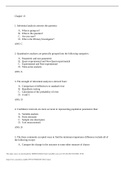
-
NSG 3029 Chapter 13 question answers
- Exam (elaborations) • 3 pages • 2022
- Available in package deal
-
- $10.49
- + learn more
1. Inferential analysis answers the question: A. What is going on? B. What is the question? C. Are you sure? D. Who is the Primary Investigator? ANS: C 2. Quantitative analyses are generally grouped into the following categories: A. Parametric and non parametric B. Quasi-experimental and Non-Quasi-experimental C. Experimental and Non-experimental D. Time-series analysis ANS: A 3. The strength of inferential analysis is derived from: A. Comparison of differences to standard error B....
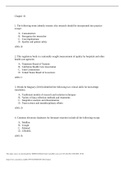
-
NSG3029 CH1 (16) question and answers 2022 UPDATED
- Exam (elaborations) • 3 pages • 2022
- Available in package deal
-
- $11.49
- + learn more
Chapter 16 1. The following terms identify reasons why research should be incorporated into practice except: A. Consumerism B. Recognize the researcher C. Cost implications D. Quality and patient safety ANS: B 2. This regulatory body is a nationally sought measurement of quality by hospitals and other health care agencies. A. Tennessee Board of Trustees B. California Health Care Association C. Joint Commission D. United States Board of Governors ANS: C 3. Woods & Magyary (2010) id...
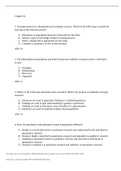
-
NSG3029 CH1 (2) Questions and Answers/Rationale.
- Exam (elaborations) • 3 pages • 2022
- Available in package deal
-
- $10.49
- + learn more
Chapter 02 1. Nursing research is a disciplined and systematic process. Which of the following is usually the first step in the research process? A. Determine an appropriate theoretic framework for the study B. Identify a gap in knowledge related to nursing practice C. Select a design that is appropriate for the study D. Complete a systematic review of the literature ANS: B 2. The philosophical assumptions and belief system that underlie a research study is referred to as a(n): A. Para...
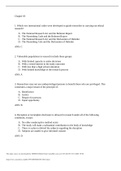
-
NSG3029 CH1 (3) Questions and Answers/Rationale.
- Exam (elaborations) • 3 pages • 2022
- Available in package deal
-
- $9.49
- + learn more
Chapter 03 1. Which two international codes were developed to guide researcher in carrying out ethical research? A. The National Research Act and the Belmont Report B. The Nuremberg Code and the Belmont Report C. The National Research Act and the Declaration of Helsinki D. The Nuremberg Cole and the Declaration of Helsinki ANS: C 2. Vulnerable populations in research include those groups: A. With limited capacity to make decisions B. With a vested interest in the study outcomes C. Wit...
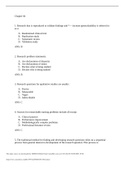
-
NSG 3029 NSG3029 CH1 (4) Questions and Answers/Rationale.
- Exam (elaborations) • 3 pages • 2022
- Available in package deal
-
- $9.49
- + learn more
Chapter 04 1. Research that is reproduced to validate findings and *— increase generalizability is referred to as a: A. Randomized clinical trial B. Replication study C. Systematic review D. Validation study ANS: B 2. Research problem statements: A. Are declarations of disparity B. Are declarations of intent C. Declare what is being studied D. Declare who is being studied ANS: B 3. Research questions for qualitative studies are usually: A. Precise B. Measurable C. Vague D. In...
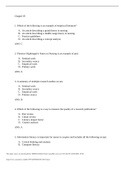
-
NSG 3029 Chapter 05 Questions and Answers/Rationale
- Exam (elaborations) • 3 pages • 2022
- Available in package deal
-
- $9.49
- + learn more
Chapter 05 1. Which of the following is an example of empirical literature?A.An article describing a grand theory in nursingB.An article describing a middle range theory in nursingC.Practice guidelinesD.An article de
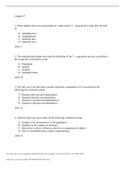
-
NSG3029 CH1 (7) Questions and Answers/Rationale.
- Exam (elaborations) • 3 pages • 2022
- Available in package deal
-
- $10.49
- + learn more
1. When subjects elect not to participate in a study and/or *— drop out of a study, this can lead to: A. Sampling error B. Sampling bias C. Selection bias D. Selection error ANS: C 2. The potential participants who meet the definition of the *— population and are accessible to the researcher is referred to as the: A. Population B. Sample C. Subjects D. Sampling frame ANS: D 3. The only way to be sure that a sample represents a population is if it incorporates the following two...
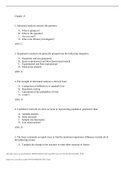
-
NSG 3029 Chapter 13 question answers
- Exam (elaborations) • 3 pages • 2022
- Available in package deal
-
- $10.49
- + learn more
1. Inferential analysis answers the question: A. What is going on? B. What is the question? C. Are you sure? D. Who is the Primary Investigator? ANS: C 2. Quantitative analyses are generally grouped into the following categories: A. Parametric and non parametric B. Quasi-experimental and Non-Quasi-experimental C. Experimental and Non-experimental D. Time-series analysis ANS: A 3. The strength of inferential analysis is derived from: A. Comparison of differences to standard error B....

-
NSG 3029 Chapter 13 question answers
- Exam (elaborations) • 3 pages • 2022
-
- $10.49
- + learn more
1. Inferential analysis answers the question: A. What is going on? B. What is the question? C. Are you sure? D. Who is the Primary Investigator? ANS: C 2. Quantitative analyses are generally grouped into the following categories: A. Parametric and non parametric B. Quasi-experimental and Non-Quasi-experimental C. Experimental and Non-experimental D. Time-series analysis ANS: A 3. The strength of inferential analysis is derived from: A. Comparison of differences to standard error B....

Study stress? For sellers on Stuvia, these are actually golden times. KA-CHING! Earn from your study resources too and start uploading now. Discover all about earning on Stuvia


